Planning on hiking a portion or the entirety of the Continental Divide Trail? If you’re taking a trip to experience the wonder of this scenic and historical path, you may be wondering what type of animals call this trail home.
In 1978, congress officially recognized the Continental Divide Trail (CDT) as a Scenic National Trail. This path spans about 3,100 miles.
The southern terminus of the trail is located at Crazy Cook Monument. It occurs just across the northern side of the U.S. and Mexico border in southwestern New Mexico. This border is now considered the most deadly for migrants in the world.
Supposedly, the name of the terminus refers to the general location where, in 1907, an irate cook killed a crew member, named Frank Evans, who was contracted to help build a fence. Allegedly, one morning, Frank Evans commented on the skills of the cook. Taking apparent extreme offense, the cook, now immortalized as the “crazy cook”, killed Evans with an axe.
The main northern terminus of the CDT, featuring a far less murder-y terminus location, occurs within the Waterton-Glacier National Park in Alberta, Canada. Between the southern and northern terminus, the CDT passes through New Mexico, Colorado, Wyoming, Idaho, and Montana.
In this guide, we’ll cover six amazing animals on the Continental Divide Trail and what portions of the trail they inhabit. The nearly 3,100-mile-long trail passes through several distinct ecosystems and climates, ranging from deserts to alpine forests and tundra, that support a diverse range of wildlife. Below, we’ll talk about some of the incredible wildlife you may encounter throughout the diverse habitats on the CDT.
1. Desert Bighorn Sheep (Ovis canadensis nelsoni)
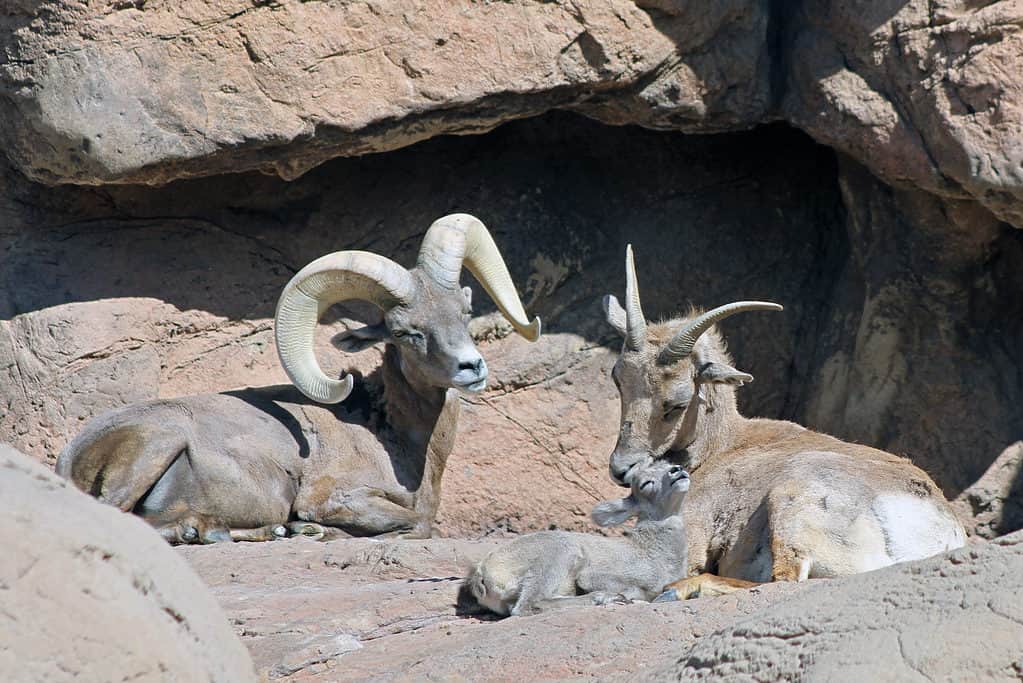
If you’re lucky, you might spot a glimpse of desert
bighorn sheep
resting among a rocky outcrop in the sun.
©iStock.com/Rainbohm
With a range that includes the southern terminus of the CDT in southwestern New Mexico, desert bighorn sheep (Ovis canadensis nelsoni) are an integral part of the trail’s southern ecology. These animals are a subspecies of the bighorn sheep (Ovis canadensis) and are particularly adapted to living in desert environments.
Desert bighorn sheep can stand up to 39 inches tall at the shoulders and weigh up to about 180 pounds. Excellent and agile climbers, these sheep can easily traverse rocky formations and canyons environments of southern New Mexico. Like all bighorn sheep, desert bighorns primarily feed on grasses, shrubs, and forbs. In particular, this species seeks out desert plants such as acacia, encelia, sweetbush, and krameria.
2. Amazing Animals on the Continental Divide Trail: Golden Eagle (Aquila chrysaetos)
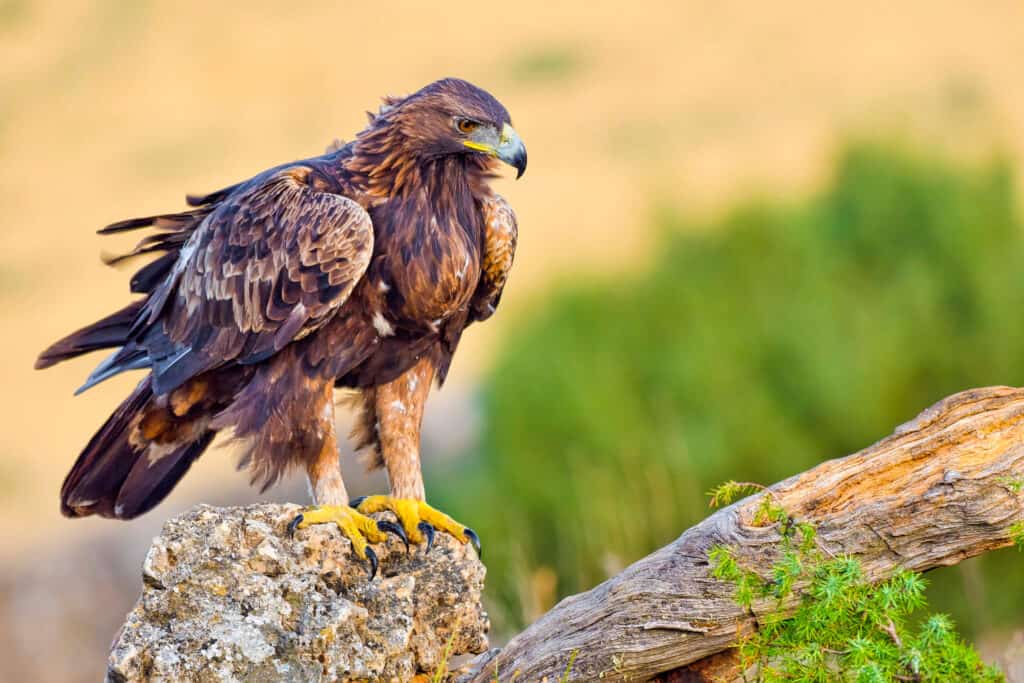
Throughout the trail, you might spot golden eagles hunting or resting on branches and rock formations.
©Al Carrera/Shutterstock.com
The golden eagle (Aquila chrysaetos) is a stunning and apex bird of prey. Its range extends from northern Mexico into Alaska and Canada. They occur most commonly in the western portion of the U.S. Depending on the season, you have a chance to see one of the amazing animals at various points along the trail.
The golden eagle is one of the fastest and most agile of raptors in North America. They hunt with their acute sense of sight, plunging toward the ground to snatch up prey in their impressive talons. Strong and fierce, the golden eagle can capture prey as large as a young pronghorn. Across the Colorado portion of the trail, you might see golden eagles in sparsely forested mountainous areas, foothills, and open, scrubby areas.
3. Bison (Bison bison)

Your best bet to see bison along the CDT occurs in the Yellowstone National Park. Make sure to give these amazing and powerful animals plenty of space.
©Gjeterhund Photography/Shutterstock.com
Once you reach northwestern Wyoming, the CDT takes hikers through portions of the stunning Yellowstone National Park, where these powerful ungulates are protected. Currently, about 5,000 bison live within the Greater Yellowstone Ecosystem. Yellowstone bison currently represent the largest population of bison that live on public land. For the past 20 years, Yellowstone National Park has managed the size of the herds through culling campaigns.
After years of hard work from indigenous and environmental activists, Yellowstone announced in 2022 a policy shift away from culling and toward prioritizing small-scale tribal hunting access and transferring bison, through the Bison Conservation Transfer Program, to tribal lands outside of Yellowstone. Eventually, this program will also include the transfer of Yellowstone bison to other public lands.
4. Amazing Animals on the Continental Divide Trail: Grizzly Bear (Ursus arctos horribilis)
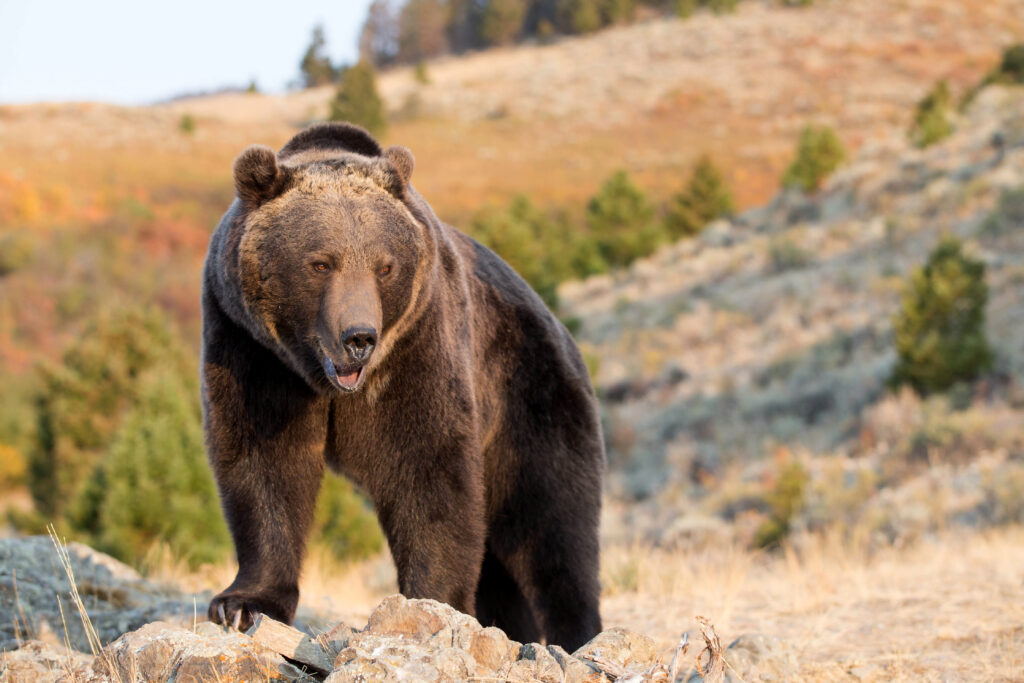
Your best bet to see a
grizzly bear
is during the Montana portion of the trail. The state is home to roughly 2,000 grizzlies.
©Dennis W Donohue/Shutterstock.com
Once you reach southwestern and northwestern Montana along the Continental Divide Trail, you might spot one of the roughly 1,800-2,000 grizzly bears (Ursus arctos horribilis) that primarily inhabit these sections of this rugged state. These amazing animals can weigh up to 700 pounds and enjoy a non-specialized, omnivorous diet. Their diet includes a range of foods including plant vegetation, tubers, nuts, berries, insects, rodents, fish, and large mammals.
Hikers are encouraged to make their presence known as they pass through grizzle bear country. You can sing, talk loudly, clap your hands as you walk, etc., to avoid startling a grizzly bear. While grizzle bears have a much higher rate of aggressive encounters with humans compared to their smaller relative, the black bear, they still tend to prefer to avoid conflict. Often, grizzly bears attack people when they feel acutely threatened. The chance of this increases if a grizzly bear becomes suddenly startled by a hiker.
5. Coyote (Canis latrans)
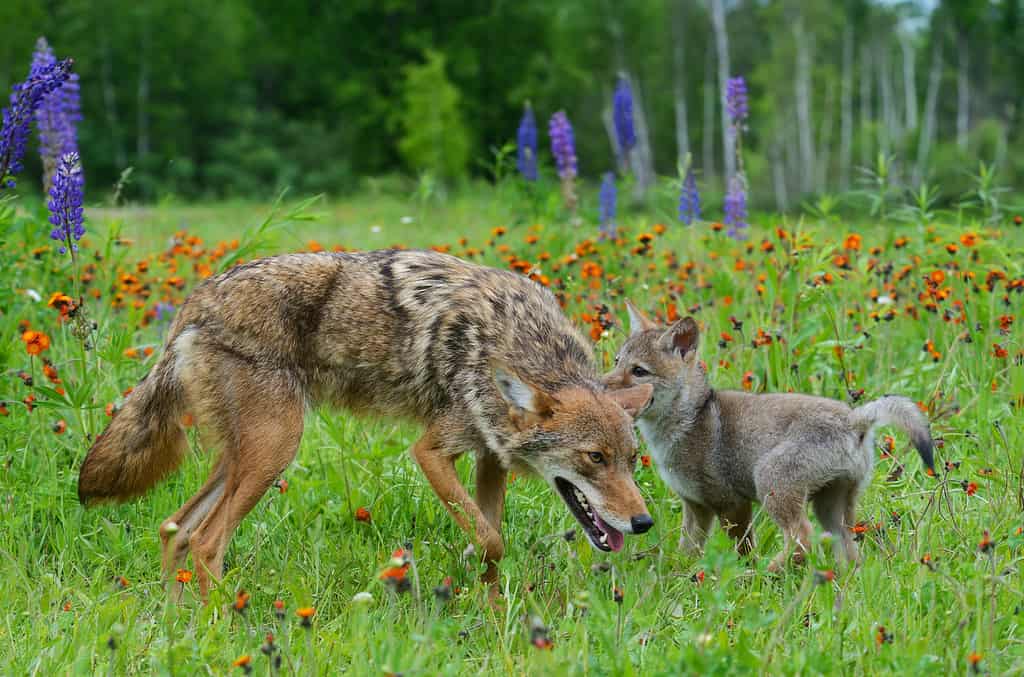
Even if you don’t spot a coyote along the Continental Divide Trail hike, you’ll likely get to enjoy hearing them yipping and howling at night.
©Betty4240/iStock via Getty Images
One animal that you may encounter on any portion of the CTD is the coyote (Canis latrans). These non-specialized omnivores are highly adapted to living in wilderness, urban, and suburban environments. Across some portions of the trail, you’re likely to hear these adaptable canids yipping in the distance or near your camp at night.
If you see coyotes along your journey, you may notice some differences in size and coat color, depending on the environment. Desert coyotes tend to be on the smaller size of their range, typically weighing only 15-25 pounds. They often sport tan or reddish-brown coats that help them blend into their environment. Coyotes in alpine regions may appear a bit larger and feature more grey in their coats.
The diet of the cunning coyote is highly variable. They are skillful hunters, scavengers, and foragers. These wild pups take advantage of a non-specialized diet that includes fruit, insects, birds, reptiles, rodents, and other small mammals.
6. Amazing Animals on the Continental Divide Trail: Prairie Rattlesnake (Crotalus viridis)
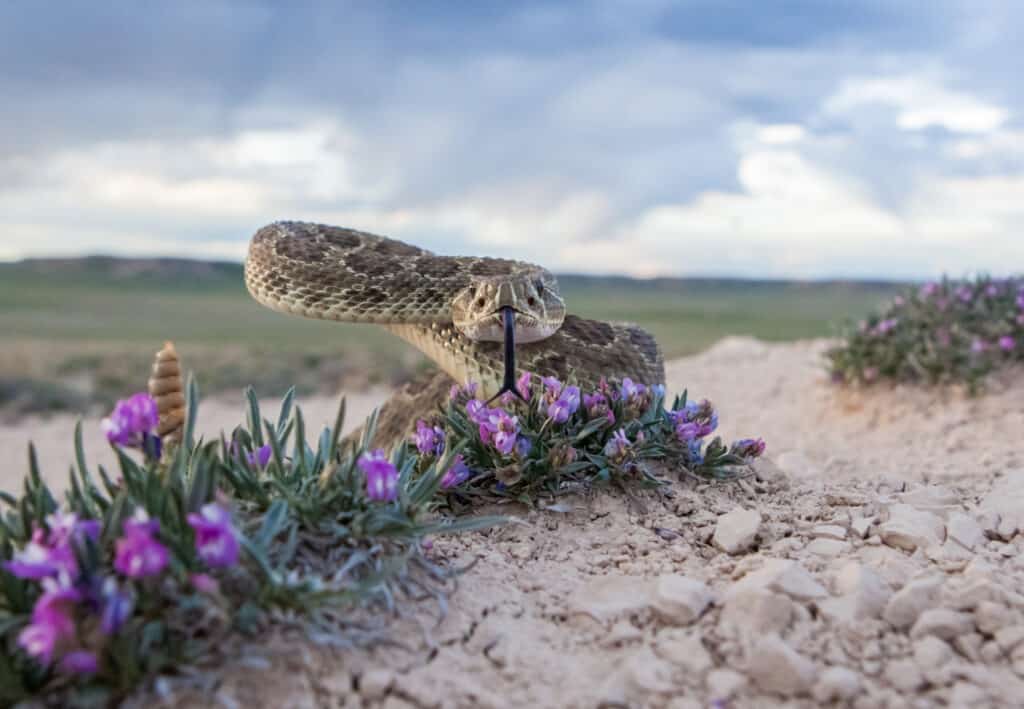
You’re most likely to come across a prairie
rattlesnake
along the New Mexico portion of the CDT. Although, its range also includes small portions of the Wyoming, Idaho, and Montana trail sections.
©iStock.com/Matt Kaminski
With a range that intersects large portions of the CDT, the prairie rattlesnake (Crotalus viridis) may cross your path during your journey. With territory spanning from Texas to Montana, this venomous snake can inhabit hundreds of miles of suitable habitat along the trail. It’s especially common throughout the entirety of the trail in New Mexico. In Wyoming, Idaho, and Montana, you may also catch a glimpse of the prairie rattlesnake in parts of the trail that feature open grasslands and prairies. In Colorado, most of the trail does not pass through suitable prairie rattlesnake habitat.
This species of rattlesnake can grow up to 5 feet in length. They feature a triangular head, blunt nose, and thick body. Depending on their environment, the prairie rattlesnake features pale green to various shades of brown and grey coloration with dark brown or black blotches that morph into rings toward their tail.
As you’re hiking, it’s important to be aware of where you’re stepping, especially when hiking in areas inhabited by rattlesnakes. It’s also important to remember that the prairie rattlesnake has no interest in conflict with humans. They would much prefer to leave an area or be left alone than risk injury in a confrontation with people. Always respect and give space to wildlife along the trail.
The photo featured at the top of this post is © Warren Metcalf/Shutterstock.com
Thank you for reading! Have some feedback for us? Contact the AZ Animals editorial team.






